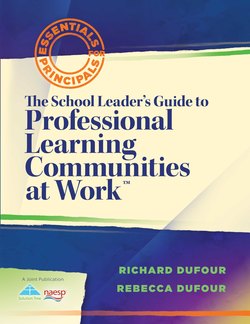Читать книгу The School Leader's Guide to Professional Learning Communities at Work TM - Richard DuFour - Страница 5
На сайте Литреса книга снята с продажи.
ОглавлениеReproducible pages are in italics
Visit go.solution-tree.com/plcbooks to download materials related to this book.
About the Authors
Introduction
What Is the Role of the Principal?
The Underlying Assumptions of This Book
What Is a Professional Learning Community?
1 Getting Started
Start With Questions
Create a Guiding Coalition
Build Shared Knowledge With Staff by Learning Together
Build the Foundation of a Professional Learning Community
Establish the Fundamental Purpose of the School
Help Staff Members Clarify the School They Are Attempting to Create
Clarify the Commitments That Are Vital to Creating the School
Establish Indicators of Progress and Strategies for Monitoring Those Indicators
Develop a Critical Mass to Support Implementation and Begin Taking Action
2 Creating the Structures for Collaboration
Organize People Into Meaningful Teams Focused on Learning
Does Your School Structure Foster Collaboration or Isolation?
Provide Teams With Time to Collaborate
Ensure Campus Layout Supports Ongoing Collaboration and Shared Responsibility for Student Learning
3 Transforming Groups Into High-Performing Teams
Engage Teams in Identifying Collective Commitments to Guide Collaboration
Engage Teams in Working Collaboratively to Achieve SMART Goals
Comprehensive School Improvement Plan
4 Focusing on the Right Work
Creating a Guaranteed and Viable Curriculum
Monitoring Student Learning Through Common Formative Assessments
Bringing New Members Into the Professional Learning Community Culture
Providing the Collaborative Team With a Role in the Selection Process
Supporting New Members
5 Demonstrating Reciprocal Accountability in a Professional Learning Community
What Gets Monitored Gets Done
Reciprocal Accountability
Team Leaders
Hope Is Not a Strategy
6 Establishing a Focus on Results
A Results Orientation
Data Analysis Protocol
A Change in Adult Practice
Teacher Supervision and Evaluation in a Professional Learning Community
7 Responding When Students Don’t Learn
Effective Intervention Ensures Students Receive Additional Time and Support for Learning
Effective Intervention Is Timely
Effective Intervention Is Directive Rather Than Invitational
Effective Intervention Is Specific and Precise Regarding the Needs of an Individual Student
Effective Intervention Provides Students Access to Staff Most Effective in Providing Help
Effective Intervention Is Fluid and Flexible
Effective Intervention Is Systematic
The Biggest Obstacle to Powerful Intervention and Enrichment
8 Communicating Purpose and Priorities
Getting Tight About the Right Things
Communicating What Is Tight
Being a Leader Who Is Willing to Confront
Giving the Gift of Coherence
9 Sustaining School Improvement
Plan for Short-Term Wins
Persevere
Build the Leadership Capacity of People Throughout the School
10 Fostering Collective Efficacy
Collective Efficacy
Conclusion
References
Index
Reproducibles
Visit go.solution-tree.com/plcbooks to download the following materials related to this book.
Introduction
Why Is Principal Leadership So Important?
Chapter 1
A Data Picture of Our School
Finding Common Ground in Education Reform
Cultural Shifts in a Professional Learning Community
Why Should We Describe the School or District We Are Trying to Create?
Schaumburg School District 54 Mission and Goals
Why Should We Articulate Collective Commitments?
The Professional Learning Communities at Work™ Continuum: Laying the Foundation
Where Do We Go From Here? Worksheet: Laying the Foundation of a PLC
The Professional Learning Communities at Work™ Continuum: Responding to Conflict
Where Do We Go From Here? Worksheet: Effective Communication (Chapter 9)
Chapter 2
Why Should We Use Teams as Our Basic Structure?
Chapter 3
Critical Issues for Team Consideration
Why Should We Collaborate?
Why Should We Create Norms?
Developing Norms
Survey on Team Norms
The Professional Learning Communities at Work™ Continuum: Building a Collaborative Culture Through High-Performing Teams
Where Do We Go From Here? Worksheet: Collaborative Culture
Why Do We Need SMART Goals?
The Professional Learning Communities at Work™ Continuum: Focusing on Results (Part I)
Where Do We Go From Here? Worksheet: Using School Improvement Goals to Drive Team Goals
SMART Goal Worksheet: Third-Grade Team
SMART Goal Worksheet: Eighth-Grade Math
SMART Goal Worksheet
Chapter 4
Why Should We Ensure Students Have Access to a Guaranteed and Viable Curriculum?
Why Should We Use Formative Assessments?
Why Should We Use Common Assessments?
The Professional Learning Communities at Work™ Continuum: Learning as Our Fundamental Purpose (Part I)
Where Do We Go From Here? Worksheet: Clearly Defined Outcomes
Where Do We Go From Here? Worksheet: Monitoring Each Student’s Learning
Chapter 5
Critical Issues for Team Consideration
Why Do We Need Widely Distributed Leadership?
Chapter 6
Why Is a Results Orientation the Key to School Effectiveness?
Data Analysis Protocol
The Professional Learning Communities at Work™ Continuum: Focusing on Results (Part II)
Where Do We Go From Here? Worksheet: Turning Data Into Information
Chapter 7
Why Should We Implement Systematic Interventions?
The Professional Learning Communities at Work™ Continuum: Learning as Our Fundamental Purpose (Part II)
Where Do We Go From Here? Worksheet: Systematic Intervention
Chapter 8
The Professional Learning Communities at Work™ Continuum: Effective Communication
The Professional Learning Communities at Work™ Continuum: Responding to Conflict
Where Do We Go From Here? Worksheet: Effective Communication (Chapter 2)
Where Do We Go From Here? Worksheet: Effective Communication (Chapter 9)
Chapter 9
Why Should Celebration Be a Part of Our Culture?
